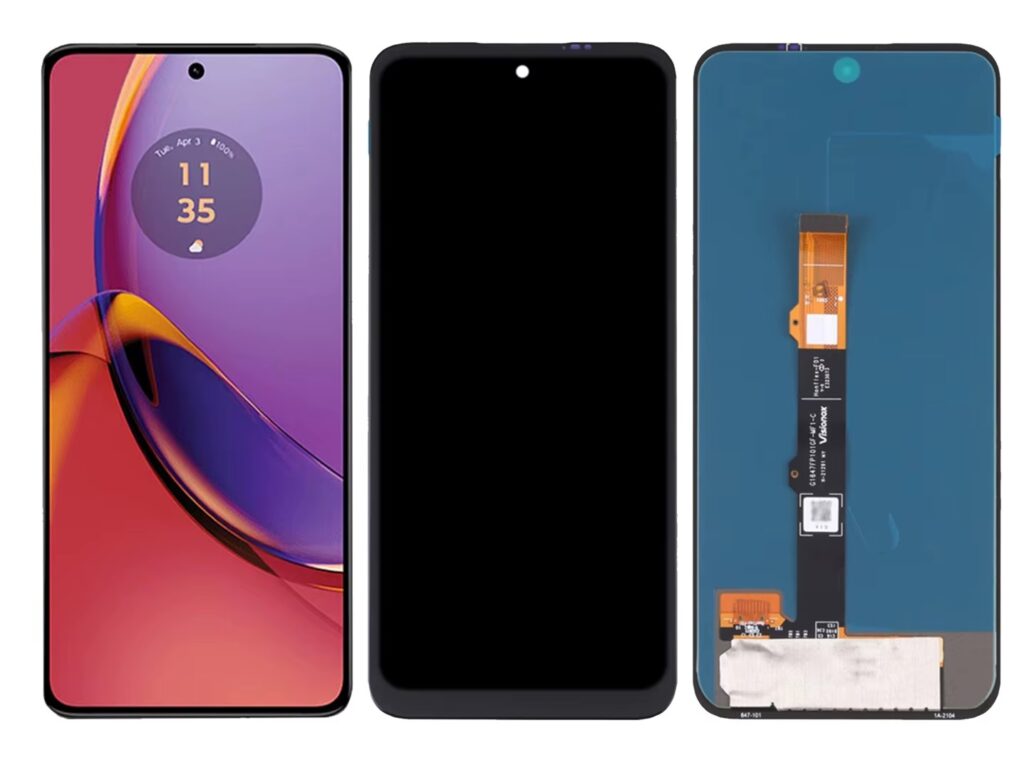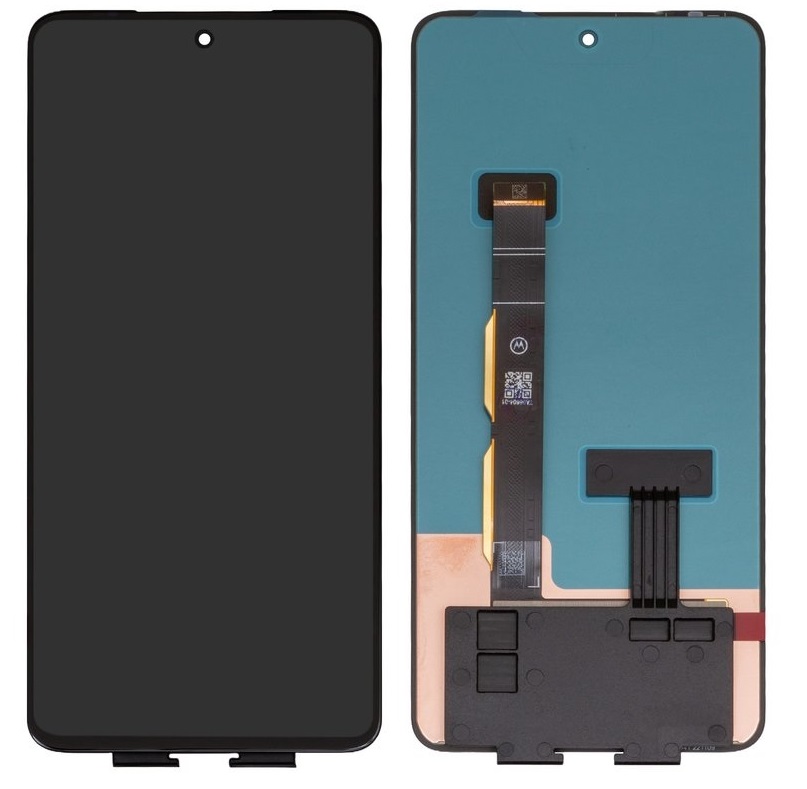
The Motorola Moto G84 features a high-quality display, which is one of the key aspects of its design. Here are the detailed specifications for the LCD screen of the Motorola G84
1. Display Type:
- AMOLED: The Motorola G84 uses an AMOLED display rather than an LCD panel. AMOLED (Active-Matrix Organic Light Emitting Diode) technology is known for its vibrant colors, deeper blacks, and energy efficiency, especially when displaying dark content.
2. Screen Size:
6.55 inches: The screen has a large size that offers an immersive viewing experience for multimedia consumption, gaming, and general use
3. Resolution:
- 2400 x 1080 pixels (Full HD+): This resolution ensures that the display offers sharp, clear visuals. It provides a high pixel density, which results in crisp text and detailed images, making it suitable for watching high-definition videos and playing games.
4. Refresh Rate:
120 Hz: The display supports a high refresh rate of 120Hz, which means smoother scrolling, better touch response, and enhanced gaming experiences. This is particularly noticeable when navigating the interface or playing fast-paced games.
5. Peak Brightness:
1300 nits: The screen can reach a peak brightness of 1300 nits, making it visible even under direct sunlight. This helps with readability in bright environments.
6. Aspect Ratio:
- 20:9: The screen has an aspect ratio of 20:9, which is commonly used for wider displays and enhances the video-watching experience by offering a more cinematic view.
7. Display Protection:
- Corning Gorilla Glass 3: The Motorola G84’s screen is protected by Corning Gorilla Glass 3, which adds durability against scratches and minor impacts.
8. Color Accuracy and Brightness:
- Vibrant Colors: Being an AMOLED display, it supports vibrant colors, wide color gamut, and deeper blacks. This results in more visually appealing content, with higher contrast compared to traditional LCD screens.
9. Touch Sensitivity:
- The display also features touch sensitivity and multitouch support, meaning it can accurately register multiple touch inputs simultaneously, providing smooth navigation and gameplay.
10. HDR Support:
Some AMOLED screens, including those on the Moto G84, support HDR (High Dynamic Range), enhancing the contrast and color range of HDR-enabled content such as videos and games.
In summary, the Motorola G84’s AMOLED display provides a combination of high resolution, smooth refresh rates, and excellent color reproduction, making it ideal for media consumption, gaming, and general smartphone usage. If you’re looking for a vibrant and fluid visual experience, the G84’s screen is well-suited for that.
Certainly! Let’s dive deeper into the key aspects of the Motorola G84’s AMOLED display and how it compares to other types of screens:
1. AMOLED Technology vs LCD

- AMOLED (Active-Matrix Organic Light Emitting Diode) is different from traditional LCD (Liquid Crystal Display) technology. In an AMOLED screen, each pixel is individually lit by organic compounds that emit light when an electric current is passed through them.
- LCD screens:
- True Black Levels: Since individual pixels can turn off completely, AMOLED screens can display true black (with no backlight bleed), which is impossible for most LCDs that rely on a backlight.Higher Contrast: The contrast ratio in an AMOLED screen is much better because the brightness levels between pixels can vary more drastically, from full brightness to completely off, providing richer and more dynamic images.
2. Screen Size and Real-World Usage:
- The 6.55-inch screen on the Motorola G84 is fairly large, which allows for a more immersive experience in watching videos, gaming, and browsing the web. This size is ideal for people who like to consume media or perform multitasking on their phones.
- Compared to a 6.1-inch screen, the G84’s larger display means more space for viewing apps, web pages, and videos.
- However, it’s also large enough to reduce ease of one-handed use, depending on hand size.
3. Full HD+ Resolution:
- With a resolution of 2400 x 1080 pixels, the G84’s screen offers a sharp image with a pixel density that ensures clear text and sharp visuals. For context:
- 1080p resolution (Full HD) is considered high-definition and is more than sufficient for most daily tasks like watching videos, browsing, and using apps.
- The term Full HD+ refers to the screen’s resolution being slightly higher than traditional Full HD, as it also accounts for the phone’s 21:9 aspect ratio (height-to-width ratio), making the screen slightly longer than conventional Full HD screens, which adds a bit of extra vertical space.
4. 120Hz Refresh Rate:
- The 120Hz refresh rate means the display refreshes 120 times per second, which offers a smoother, more fluid experience compared to traditional 60Hz screens. This is particularly noticeable in:
- Scrolling: Text and images scroll smoothly, especially when browsing the web or navigating through menus.
- Gaming: High refresh rates enhance gaming experiences by providing smoother and more responsive touch input.
- User Interface: Transitions and animations between apps and menus appear smoother and more polished.
- Real-world impact: While 60Hz refresh rates can sometimes cause noticeable lag or choppy transitions, 120Hz refresh rates in the G84 provide much smoother fluidity, making it an excellent choice for gaming, social media scrolling, and even basic tasks.
5. 1300 Nits Peak Brightness:
- A peak brightness of 1300 nits mean the display can get extremely bright under sunlight, which enhances visibility even in harsh lighting conditions. For comparison:1000 nits is generally sufficient for most outdoor conditions.
- 1300 nits takes it a step further, ensuring that when you’re outdoors in direct sunlight, the screen remains legible, which is essential for users who spend a lot of time outside.
6. 20:9 Aspect Ratio:
- The 20:9 aspect ratio of the screen gives it a slightly taller profile, which is ideal for watching movies in a cinematic format, as many modern films are shot in a similar ratio. This ratio also means more vertical screen space for apps and web browsing without feeling too cramped.
- For example, you can view more of a webpage at once compared to a phone with a 16:9 ratio, making it better for reading and browsing.
7. Durability (Gorilla Glass 3):
- The Motorola G84 uses Corning Gorilla Glass 3 to protect the screen from scratches and impacts. While Gorilla Glass 3 is not as advanced as newer versions like Gorilla Glass 5 or 6, it still provides reliable protection for everyday use. If dropped from a short height or subjected to moderate force, the screen is more likely to resist scratches and minor cracks.
8. Color Accuracy:
- Vibrant Colors and Deep Blacks: AMOLED screens, like the one on the Moto G84, produce vibrant and saturated colors. In contrast to LCDs, AMOLED displays offer richer tones, especially for colors like red, green, and blue, making the display more visually engaging.
HDR Support: The display also supports HDR (High Dynamic Range) content, which improves how colors and brightness are displayed in HDR-enabled content like streaming services (e.g., Netflix, YouTube). HDR provides deeper blacks and brighter whites, increasing the overall range and depth of color